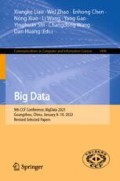Abstract
The use of artificial intelligence methods to assist in the discovery of Traditional Chinese Medicine (TCM) pairs provides practical significance for the inheritance, development, and innovation of TCM. Most of the current herb pair mining methods only consider the attribute information of a single decoction piece and are based on the existing single machine learning model, so the quality of herb pair discovery is not high. This paper uses deep learning methods to solve the problem of TCM herb pair discovering. The properties of nature, taste, and meridian of the decoction composing the herb pair were added to the data set, and the knowledge-enhanced semantic representation (ERNIE) pre-training model was employed based on context and location information. We also compared it with the herb pair discovering effect of CNN, RNN, BERT, ERNIE models and common classification models. The results show that ERNIE can find potential herb pair effectively in the collection of TCM decoction pieces, and has a high effectiveness.
Supported by National Natural Science Foundation of China (82174534) and Fundamental Research Funds for the Central Public Welfare Research Institutes (ZZ13-YQ-126).
Access this chapter
Tax calculation will be finalised at checkout
Purchases are for personal use only
References
Shang, E.X., Li, W.L., Ye, L., Zhou, W., Tang, Y.P., Fan, X.S.: Herb pair research (II) - data mining of herb pair. China J. Chin. Materia Medica 38(24), 4191–4195 (2013)
Shafaf, N., Malek, H.: Applications of machine learning approaches in emergency medicine; a review article. Arch. Acad. Emerg. Med. 7(1), 34 (2019)
Messinger, A.I., Luo, G., Deterding, R.R.: The doctor will see you now: how machine learning and artificial intelligence can extend our understanding and treatment of asthma. J. Allergy Clin. Immunol. 145(2), 476–478 (2020)
Yao, Y.Z., et al.: An ontology-based artificial intelligence model for medicine side-effect prediction: taking TCM as an example. Comput. Math. Meth. Med. 2019, 8617503:1–8617503:7 (2019)
Liu, Z.W., Chen, S.Q., Xu, S., Li, C.X.: Discovery of Chinese medicine pairs based on Association Rule Algorithm. World Latest Med. Inf. 19(20), 275–276 (2019)
Hu, M.M., et al.: A disease prediction model based on dynamic sampling and transfer learning. Chin. J. Comput. 42(10), 2339–2354 (2019)
Tang, Y.Q., et al.: Research on herb pairs (I) - formation and development of herb pairs. China J. Chin. Materia Medica 38(24), 4185–4190 (2013)
Liu, C.H., Geng, G.: Discussion on the prescription of whole scorpion based on herb pair compatibility. J. TCM 60(18), 1563–1566 (2019)
Zhang, D.Z., et al.: Improving distantly-supervised named entity recognition for TCM text via a novel back-labeling approach. IEEE Access 8, 145413–145421 (2020)
Yuan, N., Jin, H., Tian, L., Jiang, Y.G., Yu, Z.H.: Dose effect analysis of couplet medicines in TCM based on clustering and fuzzy association rules. Appl. Res. Comput. 26(01), 59–61 (2009)
Wang, Y.Q., Yang, T., Li, X.X., Xie, J.D., Dong, H.Y., Hu, K.F.: Design and application of medicine pair extraction algorithm based on joint conditional probability matrix. Mod. TCM Materia Medica-World Sci. Technol. 21(06), 1153–1160 (2019)
Lu, P., Qiu, X., Huang, X.: Recurrent neural network for text classification with multi-task learning. In: Proceedings of the 25th International Joint Conference on Artificial Intelligence, pp. 2873–2879 (2016)
Heng, Z., Zhong, G.Q.: Improving short text classification by learning vector representations of both words and hidden topics. Knowl.-Based Syst. 102, 76–86 (2016)
Ahmad, S., Asghar, M.Z., Alotaibi, F.M., Khan, S.: Classification of poetry text into the emotional states using deep learning technique. IEEE Access 8, 73865–73878 (2020)
Ji, H., Wang, Y.B., Ma, J.H.: Radon inversion via deep learning. IEEE Trans. Med. Imaging 39(6), 2076–2087 (2020)
Abdelwahab, M.A., Abdel-Nasser, M., Hori, M.: Rapid traffic congestion detection approach based on deep residual learning and motion trajectories. IEEE Access 8, 182180–182192 (2020)
Tang, W.X., Li, B., Barni, M., Li, J., Huang, J.W.: An automatic cost learning framework for image steganography using deep reinforcement learning. IEEE Trans. Inf. Forensics Secur. 16, 952–967 (2021)
Wu, X.U., Xue, G.G.: CNN fast recognition algorithm of traffic signs based on image clustering. CAAI Trans. Intell. Syst. 14(04), 670–678 (2019)
Jacob, D., Chang, M.W., Kenton, L., Toutanova, K.: BERT: pre-training of deep bidirectional transformers for language understanding. In: Proceedings of the: Conference of the North American Chapter of the Association for Computational Linguistics: Human Language Technologies, vol. 2019, pp. 4171–4186. Association for Computational Linguistics, Stroudsburg (2019)
Yu, D., Jin, T.H., Xie, W.Y., Zhang, Y., Pu, E.D.: Recognition method based on deep learning for Chinese textual entailment chunks and labels. J. Softw. 31(12), 3772–3786 (2020)
Cai, L.K., Song, Y., Liu, T., Zhang, K.L.: A hybrid BERT model that incorporates label semantics via adjustive attention for multi-label text classification. IEEE Access 2169–3536, 152183–152192 (2020)
Sun, Y., et al.: ERNIE 2. 0: a continual pre-training framework for language understanding. In: Proceedings of the AAAI Conference on Artificial Intelligence, pp. 8968–8975 (2020)
Huang, X.F., Chen, M., Liu, P.Z., Du, Y.Z.: Texture feature-based classification on transrectal ultrasound image for prostatic cancer detection. Comput. Math. Meth. Med. 2020, 7359375:1–7359375:9 (2020)
Skrlj, B., Martinc, M.: tax2vec: constructing interpretable features from taxonomies for short text classification. Comput. Speech Lang. 65, 101104 (2021)
Author information
Authors and Affiliations
Editor information
Editors and Affiliations
Rights and permissions
Copyright information
© 2022 Springer Nature Singapore Pte Ltd.
About this paper
Cite this paper
Xue, Q., Gao, B., Wen, J., Zhu, Y., Meng, X. (2022). A Deep Learning-Based Herb Pair Discovering Approach. In: Liao, X., et al. Big Data. BigData 2022. Communications in Computer and Information Science, vol 1496. Springer, Singapore. https://doi.org/10.1007/978-981-16-9709-8_10
Download citation
DOI: https://doi.org/10.1007/978-981-16-9709-8_10
Published:
Publisher Name: Springer, Singapore
Print ISBN: 978-981-16-9708-1
Online ISBN: 978-981-16-9709-8
eBook Packages: Computer ScienceComputer Science (R0)


